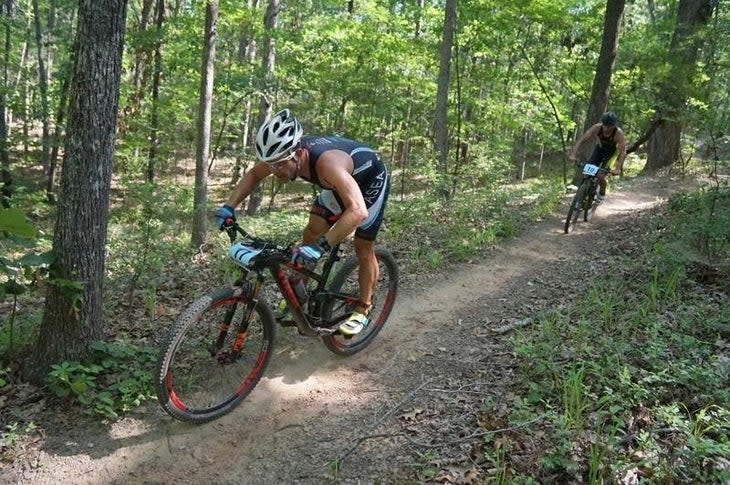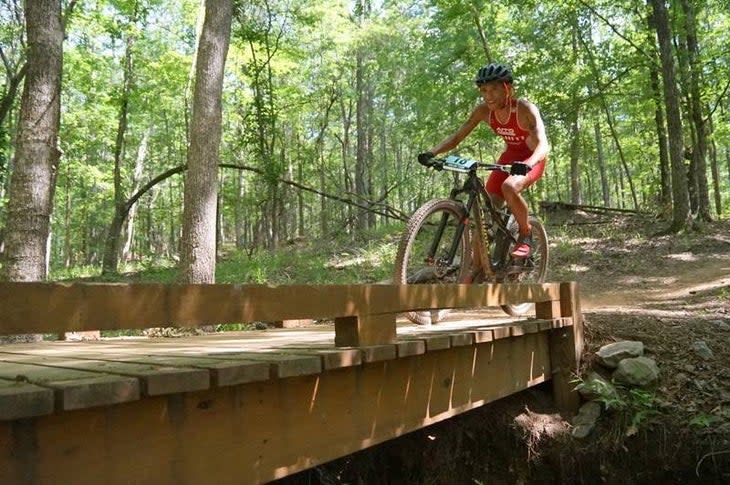Mountain Biking for Beginners: Here’s Where to Start
This article originally appeared on Triathlete
Yes, road bikes and mountain bikes are fundamentally similar: two tires are pushed by two pedals, and a handlebar steers the bike where you want to go. But that's about where the similarities end. Even the strongest roadies can find themselves intimidated by the knobby tires and technical terrain of mountain biking. But don't let that discourage you - with a small amount of adjustment (and a big sense of adventure), you can tear up the trails with the best of them. Whether you’re looking to dip your toes into off-road triathlon or simply wanting a fun ride off the roads, use these mountain biking for beginners tips from Ali Halpin, PMBIA Level 1 Certified Mountain Bike Skills Coach and head coach for Ladies AllRide and Grit Clinics, to seamlessly transition from the road to the trail.
RELATED: Mountain Biking = A Triathlete’s Secret Strength Training Weapon
Know Your Ride
When choosing a mountain bike, don't look for the exact same fit and features as your roadie. A different kind of riding require a different kind of bike, says Halpin: "The cockpit of a mountain bike has a much shorter reach, so you sit closer to the bars and also much more upright than on a road bike." Other notable differences on the MTB include a shorter stem and wider handlebars for better handling.

Don't Clip In
Though you may have years of experience riding your road bike, one of the best mountain biking for beginners tips is to see yourself as a true newbie. That means - yes, we're serious - platform pedals. Though clipping in creates more power in the pedal stroke, power isn't the thing you should be focusing on at first. Technique is, and that takes a while to master. In other words: You're probably going to fall. A lot. "If you're starting out mountain biking, get flat pedals and compatible flat mountain bike shoes. Riding flats can really help you feel more confidence since you don't have to worry about getting out of your pedals. You can also learn how to do skills with proper form and technique. When clipped in, you can cheat with some skills, which can create bad habits."
Choose a Beginner Trail
Many a roadie has been humbled by an overly ambitious attempt at difficult, technical trails with steep climbs and even steeper drop-offs with little room for mistakes. It's best to begin on a truly easy, beginner-friendly mountain bike trail, then increase difficulty as you improve your handling and climbing skills.
Be Ready to Dance
Perhaps the biggest difference between road riding and mountain biking is the amount of movement that takes place. Instead of a smooth pedal stroke in an aerodynamic position, mountain bikers are constantly adapting to the trail. "I like to call climbing a dance," says Halpin of adjusting to mountain biking as a beginner. "you are always shifting your weight and making micro adjustments to keep traction and balance while climbing."

Get Out of the Seat
"The number one skill that can immediately make you feel more confident as a mountain biker is to stand up out of the seat with what we call level pedals - so pedals at the 3 and 9 o'clock positions." When you're seated on a mountain bike, the hips are locked to the saddle, making it a lot harder for the bike to move freely. Standing up allows a beginner mountain biker to maintain better control of the bike as well as stay centered on the bike when going downhill or over obstacles. Level pedals are also important for control and safety, as a dropped pedal (at 6 o'clock) runs the risk of colliding with obstacles in the trail.
Corner Like a Champ
Tight switchbacks on a trail are the norm, not the exception, meaning road riders will need to master a new set of cornering skills. Instead of entering a corner in a seated position with a leg down to leverage weight in steering, like road riders do, a mountain biker enters a corner standing and in level pedals. "This allows for more traction, as well as what we call bike-body separation," explains Halpin.
If you enter a corner and have more speed than you want, use your rear brake, as this will keep your front wheel rolling through the corner.
Don't Think - Just Go
The roadie mentality is to avoid all obstacles whenever possible, but on a mountain bike, the obstacles are the point. It may take a while to deprogram your thinking from "go around this rock" to "go over this rock." That's why a beginner-friendly trail is so important, as the obstacles are often minor and can help you gain confidence keeping the pedals moving over and through any hurdles you see. Soon, you'll learn to trust your bike and its ability to absorb the rough ride.
The Biggest Mountain Biking for Beginners Tip: Have Fun!
When you're first starting out, the objective should not be speed or power. It should be the thrill of a new challenge on new trails. The less pressure you put on yourself, the more fun you'll have - and the more fun you have, the more you'll ride. Get out there and kick up some dirt with a smile on your face!
Not yet ready to send it on a mountain bike, but still looking to get off the roads? Consider gravel riding! Check out Gravel Cycling 101: A Triathlete’s Guide to Gravel Basics.
For exclusive access to all of our fitness, gear, adventure, and travel stories, plus discounts on trips, events, and gear, sign up for Outside+ today.

